What It's Like To Be Bitten By A Pit Bull
Denise James, 'Let's Talk Animals'
 Denise James loves animals. She also loves talking about them, a lot! Her love for dogs was not soured when she was bit in the face by a pit-bull. She'll tell us what went wrong and how to avoid being a dog treat. She currently lives in Tennessee. Before that, she lived in upstate New York and was the Founder and Host of the radio program, "Let's Talk Animals." She tells us a dog bit her, so she had to take some time off.
Denise James loves animals. She also loves talking about them, a lot! Her love for dogs was not soured when she was bit in the face by a pit-bull. She'll tell us what went wrong and how to avoid being a dog treat. She currently lives in Tennessee. Before that, she lived in upstate New York and was the Founder and Host of the radio program, "Let's Talk Animals." She tells us a dog bit her, so she had to take some time off.
People are always asking her what breed it was, but she usually doesn't tell them. However, the dog was a Pit Bull mix. At the time, the dog was growling and everyone was nervous around it. But as she always said on her show, you have to be responsible. Even her Chihuahuas, she had 13 dogs and now she's down to seven, but you know, they are little yappers and they can lick and they're annoying to other people. So you have to be responsible and put them in another room when people are visiting.
The dog that it her was actually a family member's dog and Denise states she has no hard feelings towards the dog. The dog was at her feet, and she says she is very intuitive, and she kept saying to herself to look away. So, this dog looked up at her first and then she looked down and said, "Hello Boy," and said his name. The dog then just leaped up and grabbed the left side of her bottom lip. The dog ended up taking out a chunk of flesh from her face. She said she knows about sewing, so she knows that sewing is seamed together, and she didn't care about a scar. She went to the hospital and everyone said it was bad. Then, this amazing doctor came in and she asked him if he could fix it and he said yes. Denise then asked him if he done anything like this before. He said, "Well, I take cancer out of people's mouth."
At the time, Denise said she was perky and happy because she never lost faith. At one point she asked, "Why Me?" Then she was like, "Why Not Me!" She thinks because she in the animal industry that it's made her more aware, because she puts her face in horses and cows and dogs. Denise tells us that this dog is no longer living. She also stresses that's she didn't ask for it to be euthanized.
Denise explains that there's a new law that's coming out right now in upstate New York that after a dog bites once, they shouldn't be euthanized. The law states that they should receive treatment and be given a second chance.
But in Denise's case, the insurance company would not cover the owners of the dog again, unless the dog was put to sleep, or removed from the home. She states if that were her, she would have found a loving home for the dog. It was difficult thing, as he was only two years old and it wasn't his fault. It was the responsibility of the pet owner. This type of responsibility lies with every single pet owner. Denise doesn't care if it's a docile dog; animals have a mind of their own.
Because she is intuitive, she knows when her dogs talk to each other and she can pick up on what they're about to do and say. She has a Yorkie and a Chihuahua that keep fighting with each other. The Yorkie kept telling the Chihuahua how pretty she was because she's got long hair and that mommy loves her more. Denise explains that she doesn't love any one more than the others.
Denise loves her animals so much, but does she think she is over the top? She says she is so obsessed that she won't eat when she's in the middle of finding the correct dog bed. Or, she puts her head in the birdcage when she's decorating it for her parrot. She admits that she is totally obsessed. She also tells us that her husband is the most patient person in the world.
When one of Denise's animals passes away, she says they "left." She doesn't like the terms, 'put them down' or 'euthanized.' She says she helps them to leave and then they go on to their next life.
Visit Website
#OpossumLivesMatter
Lea Murray, The Opossum Pouch
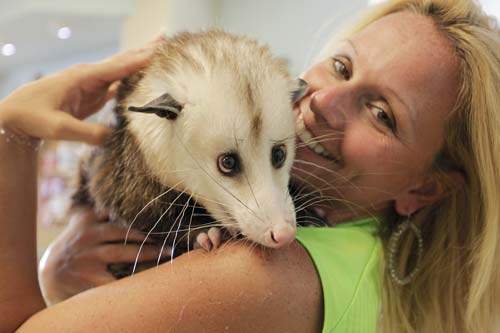 Opossum guardian and advocate Lea Murray is mother to several opossums, including Kricket, the Fruit Loop eating marsupial in this viral video. Lea is outraged about a recent Inside Edition broadcast that painted opossums as a typhus vehicle. She says the much maligned and misunderstood critter is actually good for humankind.
Opossum guardian and advocate Lea Murray is mother to several opossums, including Kricket, the Fruit Loop eating marsupial in this viral video. Lea is outraged about a recent Inside Edition broadcast that painted opossums as a typhus vehicle. She says the much maligned and misunderstood critter is actually good for humankind.
Lea Murray is the Medical Research Director for The Opossum Pouch and explains the difference between a possum and an opossum. She says it's really the location. Here in the United States we have the didelphis virginiana, which most people call a possum. However, technically it is an opossum. The possum and opossum are actually different animals. In Australia, there are actually 65 different species of opossums.
Being a Medical Research Director for opossums means Lea is looking for answers to all the problems and all of the medical issues that opossums have, because unlike cats and dogs or any other mammal that we are really familiar with treating, you just can't approach anything that you deal with opossums the same way.
Lea currently has three opossums including a dwarf opossum named Pineapple and a Fruit Loop eating opossum named Kricket. Lea uses her opossums for education. She's not a rehabilitator per se, or at least she tries to say she's not. Rehabilitators have to release the opossums back into the wild and Lea doesn't like to release them. She claims it's heartbreaking, but she knows it's necessary. It's just that's not what she does for the organization. She has education animals and travels around to schools and a lot of different events that go on in the community. This way she can take advantage of educating people about opossums because they're so severely misunderstood and under appreciated. In captivity, opossums only live about three years. In the wild, they live less than two years.
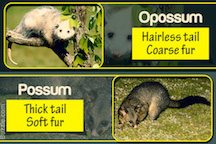 Previously, Inside Edition did a story about opossums invading American cities, sparking typhus fever outbreak. Of course we know that all these magazines try to glamorize and maybe even exaggerate news a little bit to make it spectacular.
Previously, Inside Edition did a story about opossums invading American cities, sparking typhus fever outbreak. Of course we know that all these magazines try to glamorize and maybe even exaggerate news a little bit to make it spectacular.
The takeaway message from that newscast, according to Lea, was pretty alarming. During the cast, they were poking at an opossum to get a response so it would open its mouth, growl and hiss. Lea explains that by nature they are really docile animals. They'd rather just be left alone. So the takeaway message from that newscast was that opossums will break into your home and attack you and give you typhus. Lea says if she were just anyone in the general public that would be alarming to her. It gives everybody a fear that is unnecessary. She said its really alarming because they do so much to try to protect these opossums and then there is a newscast like that that sends people into a panic. She said it actually gives people a justified feeling to protect their families by going out and killing every opossum that they see. This just mortifies her! She feels it will create an on going an onslaught of ridiculous slaughter of innocent opossums. She said this is unnecessary and she thinks something has to be done to reverse that message.
Dr. Debbie speaks up about the infectious disease part of it, because there is a valid message when we talk about diseases you can get from wildlife. So things like murine typhus (transmitted by fleas) is a genuine risk from not just opossums, but also from rats that might have fleas on them. So the bacteria that the fleas have pass this type of disease to people potentially. So for her, the message wouldn't be to try to kill every opossum, but we don't want to really have that wildlife crossover into where we live. So the message that she would want to say is how can we make sure that the opossums enjoy their life elsewhere, not under our house or in our attic and not having that crossover to where they can still be a valid health risk.
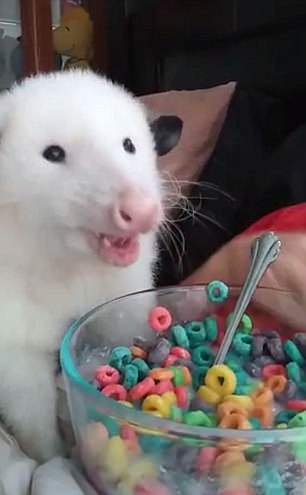 Although Lea agrees, she also feels like some other things could have been done. In the newscast, they showed a trapper that was trapping the opossums and just relocating them. She said that doesn't do anything as far as she's concerned of helping the problem or the issue. All you did was take that opossum with those fleas, that they feel are responsible for carrying typhus, and put them in another place. She wants to know why aren't we attacking the problem of the fleas? There are so many big industries out there like Merck who has products like Bravecto. One application provides three months of protection against fleas. But instead, we are picking up these opossums and relocating them and taking that problem somewhere else.
Although Lea agrees, she also feels like some other things could have been done. In the newscast, they showed a trapper that was trapping the opossums and just relocating them. She said that doesn't do anything as far as she's concerned of helping the problem or the issue. All you did was take that opossum with those fleas, that they feel are responsible for carrying typhus, and put them in another place. She wants to know why aren't we attacking the problem of the fleas? There are so many big industries out there like Merck who has products like Bravecto. One application provides three months of protection against fleas. But instead, we are picking up these opossums and relocating them and taking that problem somewhere else.
Lea feels that treating them with flea medications is at least another angle that we could look at. She tells us that last year Merck had some of the Bravecto product that was short dated so they were selling it very inexpensive and in fact, giving it away. Why can't we take advantage and instead of disposing of that entire valuable product, use that into protecting our wildlife instead of making everyone afraid these animals. She understands that there is a concern here, but she thinks we need to address it differently and not put opossums in harms way.
People should know that opossums aren't the only ones that have these fleas. It's the feline flea. So feral cats have them. Raccoons have them. It's not just the opossum, but they were the only ones targeted for this.
Can you imagine the flack Inside Edition would get if they did a story about eliminating cats instead of opossums? Lea still hopes they are going to get a lot of flack from targeting opossums.
Opossums are amazing and Lea wants everyone to know. There's so much people don't realize about them. They are immune to venomous snakebites and it's almost impossible for them to get rabies. They even eat over 5,000 ticks in a season and Lyme disease is a real threat from ticks. She said it's so frustrating that they don't get credit for all the amazing things that they do, and they should!
Visit Site
Black Widow Spiders Poisonous to Pets - Dr. Debbie
 Pet Threats Come in All Sizes
Pet Threats Come in All Sizes
Our doggie family ambled along on our typical morning walk along the community trail. With a family of two Labradors and a Yorkie mix, my crew is always up for fun and they investigate anything and everything.
Sometimes it's a crunchy cockroach snack or the fortunate edible remnant in a discarded candy wrapper. My dogs enjoy the "date game" where they snatch up shriveled fruit fallen from date palms, crunching away before the mom and dad notice. And sometimes it's a half-hearted game of chase with an unsuspecting rabbit. A more gut wrenching episode once involved my Labrador ingesting a rat with tail slipping down his gullet like a piece of spaghetti. My furry kids are professional trouble finders so I try to keep a watchful eye for things that make them go "Oooh," and make me go "Ugh!"
Female Black Widow Spider
While walking along the pedestrian pathway we came upon today's discovery - spiders and lots of them living in the recesses of a block wall. The hairs on my arm stood up as my Yorkie mix approached their lair. I recognize what these spiders are and what could happen to a 16-pound pup.
The long legged spiders were over 1 1/2" in length, black in color with a distinctive orange hourglass mark on its underbelly. Meet the black widow spider, a common arachnid found in every state in the U.S. except Alaska.
The Black Widow Bite
Black widow spiders contain a potent neurotoxin that causes pain, swelling and can lead paralysis. Female black widows are the dangerous ones, while the males rarely ever bite. While some black widow bites go unnoticed, others cause immediate pain at the site or result in pain at the nearest lymph node. Pain intensity reaches its maximum within 1 to 3 hours after the bite, but can last up to 48 hours.
Symptoms of a black widow bite appear within 8 hours after bite an include muscle twitching, restlessness, rigid abdomen and difficulty breathing. Symptoms may result in high blood pressure, a racing heart rate, seizures and collapse. Dogs are more resistant to a black widow bite, but still can suffer serious illness. Cats are very sensitive to the toxins and can suffer fatalities.
Symptoms of black widow bite include:
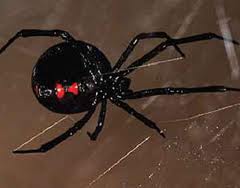 - Pain and numbness around bite site
- Pain and numbness around bite site
- Anxiety
- Racing heart rate
- Muscle pain and stiffness, especially abdominal muscles
- Difficulty breathing
- Paralysis
- Seizures
Treatment for Black Widow Spider Bite
Call your veterinarian if you suspect your pet was bitten by a black widow. Initial home emergency care of a black widow bite may include ice packing bite area and oral antihistamines like Benadryl. Your veterinarian will need to see your pet to evaluate and treat the more serious symptoms. Treatment may include medications to control muscle spasms and seizures. Blood pressure and blood sugar are monitored and intravenous fluids may be administered. An antivenin is available for more serious confirmed cases of black widow bite.
Prevention
Avoidance of spider habitats is the best prevention. These eight-legged critters favor dark recesses both indoors and outdoors. Look for cobwebs with a distinctive funnel-shaped opening at the top. And keep a close eye on your dog when out exploring. Inquire about spider control methods with your pest control company.
With pet noses so close to web level, the risk of black widow bites is just natural to being a dog. Our morning spider encounter ended without any drama, thankfully. After one firm "No!" my doggies retreated to unearth some other lucky find. Here's to hoping it doesn't involve any rats or bugs next time.
Featured veterinarian known as "Dr. Debbie" on national pet radio program, Animal Radio. Ebook author of "Yorkshire Terriers: How to Be Your Dog's Best Friend"; "Pugs: How to Be Your Dog's Best Friend"; "Mini Schnauzers: How to Be Your Dog's Best Friend"; and "Shih Tzu: How to Be Your Dog's Best Friend." Dr. Debbie's books.
Visit Website
 The Dogfather's Grooming Tip with Joey Villani
The Dogfather's Grooming Tip with Joey Villani
Trimming Cat Nails - No Gauntlets Needed
Trimming your cat's nails may not be your favorite activity, but it's truly important for their health. Joey Villani has tips to make it a little easier and less bloody. It doesn't need to be a big deal for you or your cat.
Joey tells us that he frequently receives emails from people who want to cut their cat's nails. However, after they attempt to cut them, they realized that might not have been a good idea and they should have gone to a professional.
Whether you are cutting a dog's or cat's nails, according to Joey, it's one of those things that if it's not done properly, it can cause a lot of discomfort. It can even sometimes cause injury not only to the pet, but to you as well, because you don't know if they're going to bite or scratch you. You also don't know if they're going to jump down and injure themselves if they are not properly restrained. There's a lot of variables that go into something that's basically very simple for a professional, but could be very difficult and very traumatic when you're trying to do it at home.
However, if you're one of those people that have to do it for whatever reason, Joey has some tips.
First of all, he states if the nails are actually growing into the pads, go to your veterinarian, as this can lead to infection. However, if the nails are just long and you are determined to cut them yourself, he recommends two people for the job. One person needs to scruff the cat that knows how to do it properly by also holding the back legs and restraining them. The last thing you want your cat to do is to dig out a chunk of muscle out of your forearm with their back, feet. Just remember one thing, there's one leg now that's still free and clear. So you want to make sure that you pay attention.
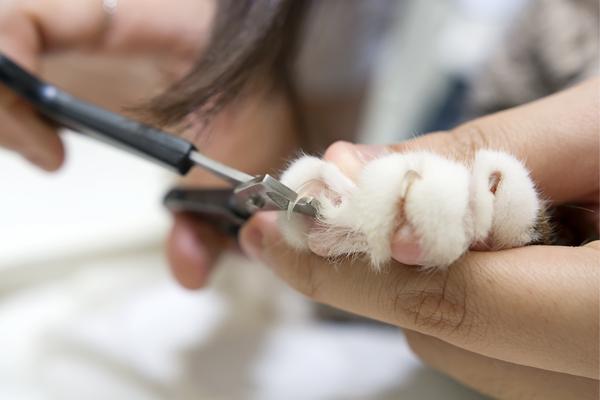 Use a sharp nail clipper made just for cats. A lot of people like to use regular home clippers that you would use on your own nails. But use something that's designed to be used on your pet.
Use a sharp nail clipper made just for cats. A lot of people like to use regular home clippers that you would use on your own nails. But use something that's designed to be used on your pet.
When clipping the nails, you only need take off the tip. This way you don't have to worry about the quick or about cutting it too short and making them bleed. Just take off the sharpness of the nail. If you do that every four to eight weeks and you maintain it should be enough.
But again, if you can stay away from doing this yourself and leave it to the professionals, you'll be much happier. According to Joey, it's worth the $10 to $20 that it cost to have it done.
Animal Radio News - Lori Brooks
 Not Everyone Picks Up After Their Dog
Not Everyone Picks Up After Their Dog
In Memphis, Tennessee, a couple was out walking their dog when they saw a sign in a yard. It was also posted on social media, which attracted a lot of attention. Everyone has strong thoughts on people who do not clean up after their pets, except for the person who doesn't clean it up. The sign said: "Please do not leave your huge piles of poop here anymore." There were also plastic bags attached to the signpost. Memphis pet owners better watch out because the city, like many others, has an ordinance, which makes it illegal for pet owners to leave a pet's poop on public or private property. And in this day and age of technology, so many people having security cameras, so you can be tracked down. Just pick up the poop.
Pet Hoarders Have Their Own Disorder
 Hoarders are people with a disorder that causes them to collect objects. But people who collect things and objects are not the same as people who collect animals. A study, published in the journal Psychiatry Research, takes a look at the motivations of people who hoard animals. This study suggests that animal hoarding should be classified as an independent disorder with the hope of developing specialized treatments to help these people cope with the compulsion to collect critters. Animal hoarders acquire and live with dozens or even hundreds of creatures in their homes, causing suffering for both the hoarder and animals. The people and their creatures often live in poor conditions; the animals often lack adequate food and medical treatment. And though this seems similar to object hoarding, this new study says there are several differences that may influence treatments. Object hoarders are pretty much evenly split between men and women, but roughly 73-percent of animal hoarders are women. Their motivations also differ. When you talk with object hoarders, they talk about hoarding objects because they might need them some day. However with animal hoarders, their thoughts are, these animals need me, and I need them. It's also more difficult to help animal hoarders because they are really suspicious and believe those who want to help them are really there to steal the animals. The results showed the average hoarder had 41 animals, with one animal hoarder having 170 dogs and 25 cats. In the United States authorities discover between 900 and 2,000 cases of animal hoarding every year, with about 250,000 dogs, cats and other animals being the victims.
Hoarders are people with a disorder that causes them to collect objects. But people who collect things and objects are not the same as people who collect animals. A study, published in the journal Psychiatry Research, takes a look at the motivations of people who hoard animals. This study suggests that animal hoarding should be classified as an independent disorder with the hope of developing specialized treatments to help these people cope with the compulsion to collect critters. Animal hoarders acquire and live with dozens or even hundreds of creatures in their homes, causing suffering for both the hoarder and animals. The people and their creatures often live in poor conditions; the animals often lack adequate food and medical treatment. And though this seems similar to object hoarding, this new study says there are several differences that may influence treatments. Object hoarders are pretty much evenly split between men and women, but roughly 73-percent of animal hoarders are women. Their motivations also differ. When you talk with object hoarders, they talk about hoarding objects because they might need them some day. However with animal hoarders, their thoughts are, these animals need me, and I need them. It's also more difficult to help animal hoarders because they are really suspicious and believe those who want to help them are really there to steal the animals. The results showed the average hoarder had 41 animals, with one animal hoarder having 170 dogs and 25 cats. In the United States authorities discover between 900 and 2,000 cases of animal hoarding every year, with about 250,000 dogs, cats and other animals being the victims.
 Listen to the entire Podcast of this show (#1096)
Listen to the entire Podcast of this show (#1096)





